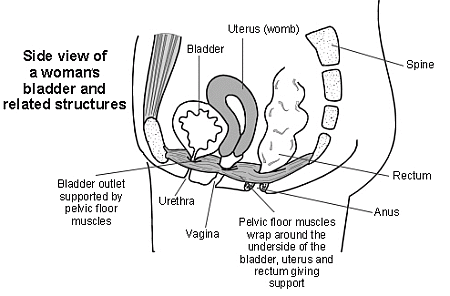There are a number of solutions that can assist with the loss of bladder control, an overactive bladder or stress or urge incontinence. Often the cause of involuntary urine leakage comes down to a weak pelvic floor.
The pelvic floor helps control the passing of urine, the opening of the bowels and contributes to sexual sensations during intercourse. The Pelvic Floor Muscles wrap around the underside of the bladder and rectum. The picture below clearly illustrates how the pelvic floor controls these essential functions.

Strengthening the pelvic floor muscles is a good (painless and free) first step to stopping stress incontinence. About 60% of cases can be cured or much improved using specific pelvic floor exercises.
The sort of exercises advised are as follows. We gratefully acknowledge http://www.patient.co.uk/showdoc/23068767 as the source for these exercises.
“1. Sit in a chair with your knees slightly apart. Imagine you are trying to stop wind escaping from your anus (back passage). You will have to squeeze the muscle around the anus. You should feel some movement in the muscle. Don’t move your buttocks or legs.
2. Now imagine you are passing urine and are trying to stop the stream. You will find yourself using slightly different muscles to the first exercise, and these are the ones to strengthen. Next time you go to the toilet try the ‘stop test’. This means halfway through emptying your bladder use these muscles to try and stop the flow of urine. Don’t be discouraged if you are only able to reduce it slightly. With time you should be able to stop the flow completely. If you are not sure that you are exercising the right muscles, put a couple of fingers into your vagina. You should feel a gentle squeeze when doing the exercise.
Practising the exercises.
- Sit, stand or lie with your knees slightly apart. Slowly tighten your pelvic floor muscles as hard as you can. Hold to the count of five, then relax. Repeat at least 5 times. These are called slow pull-ups. Do the same exercises quickly without counting to 5. Repeat at least 5 times. These are fast pull-ups. Do 5 slow pull-ups and 5 fast pull-ups at least 10 times a day.
- Get into the habit of doing exercises whilst going about everyday life. For example, when answering the phone, washing up, etc.
- Do the exercise at times when you feel you might leak, for example, when lifting something heavy or when you cough.
- Do the ‘stop test’ on your urine once a day. After several weeks the muscles will start to feel stronger. You may find you can hold on longer than 5 seconds and you can do more pull ups without the muscle feeling tired. You should find it easier to stop your urine.
It takes time and practice to become good at these exercises. But, you should start to see benefits after a few weeks. Do persevere and, if possible, continue exercising as a part of everyday life to stop the problem recurring.” Like any muscle if you don’t use it – it gets flabby and weak so do the pelvic floor exercises regularly.
Other Solutions
There are devices around that will help you to do your pelvic floor exercises eg, the PFX2 providing biofeedback to help you measure how well you are doing your exercises and how strong your pelvic floor muscles are getting. If you got to Pelvic Floor Excercise you can find a large product range backed up with information, research reports and summaries, and links to practitioners and services, all available on the website. Their aims are to provide a range of products selected using criteria of quality, effectiveness and value, and to give women a choice of which product suits them.

There are re-usable cloth incontinence pads available that are comfortable to wear, inexpensive and give you peace of mind.



